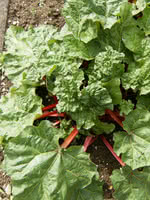Mon-Fri 9am - 5pm Mountain time
Canada Red Rhubarb vs Nodding Onion
Allium cernuum
Rheum rhabarbarum Canada Red
NOT AVAILABLE THIS SEASON - MIGHT RETURN
NOT AVAILABLE THIS SEASON - MIGHT RETURN
Nodding Onion is a native perennial wildflower known for its nodding clusters of flowers that range in color from white to pink to purple. The lightly scented blooms provide pollen and nectar for pollinators, especially bees, which can collect while hanging upside down, a capability most other insects lack.
The narrow, grass-like leaves of the Nodding Onion can be used as a seasoning in cooked dishes, though bulbs and raw leaves should not be eaten in large quantities. All parts of the plant have an onion-like aroma when bruised, which helps deter deer and rabbits. They can self-seed readily, so removing spent blooms helps manage their spread. Tolerant of a range of soils, including alkaline, it is well-suited for a variety of plantings, including pollinator gardens and naturalization projects.
The Canada Red Rhubarb is a perennial vegetable grown primarily for its sweet-tart edible leaf stalks that are commonly used in jams, sauces and pies. This plant develops from a short crown, growing thick stems with large heart-shaped leaves that retain their green color throughout the season. In summer, white flowers appear above the green foliage.
The Canada Red Rhubarb typically grows shorter, more slender stalks that feature a striking red color with a sweeter flavor than other cultivars. For a more reliable crop, it is recommended not to harvest the Canada Red Rhubarb in its first year of growth to allow its root system to establish.

